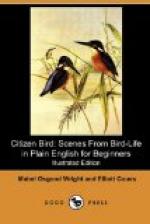Bill blackish and yellowish; legs greenish; claws brown; eyes yellow.
A Citizen of temperate North America, but a very shy and solitary bird, who will not be neighborly and is oftener heard than seen in the bogs where he likes to live alone. He makes a loud noise that sounds like chopping wood with an axe or driving a stake in the ground with a mallet; so he is called the Stake-driver by some people, while others name him Thunder-pumper and Bog-bull. His body is about as big as a Hen’s, and he is sometimes known as Indian Hen, though his very long beak, neck, and legs are not at all like those of a Hen.
A member of the guild of Wise Watchers, who keeps a sharp lookout for the reptiles and little fishes he spears with his strong pointed bill, and places his nest on the ground; the eggs are drab-colored, not pale green like those of most members of the Heron family.
A BONNET MARTYR AND A BLUE GIANT
“You promised to tell us about four Herons—please, who are the other two?” asked Dodo, when she had finished writing these tables, and had buttoned her book into the pocket of the long gray linen apron which the Doctor had taught both Olive and herself to wear on those excursions, whether they hunted birds, flowers, or butterflies.
“Boys have pockets—how I wish I was a boy!” Dodo had said, after she had been at Orchard Farm a couple of days. “So do I,” had echoed Olive; “there is always something to carry, and everything seems either to fall out of girls’ pockets, or to be smashed flat.”
“If you will only promise not to turn into boys, I will furnish you with pockets,” the Doctor had said, and he had kept his word as usual.
[Illustration: Snowy Egret Or Bonnet Martyr.]
“Did I say four Herons?” he now asked. “Yes, to be sure; there are two more that will interest you—the Snowy Egret or Bonnet Martyr, and the Great Blue Heron or Blue Giant.”
“Bonnet Martyr? What a strange name for a bird! Why do you call him that? Do they live about here?” asked Nat.
“They do not live so far north as this, though they sometimes stray through the Middle and Northern States. But in the Southern States, and Florida in particular, they used to live in vast colonies. Now they are being surely and quickly put out of the world by the cruelty and thoughtlessness of House People—the particular kind of House People who wear women’s hats and bonnets.
“Once these Egrets covered the southern lowlands like drifting snow—for they are beautifully white. In the nesting season, when many birds are allowed some special attraction in the way of plumage, bunches of long, slender, graceful plumes grow on their backs between the shoulders and curl up over the tail.
“In an evil moment some woman, imitating the savages, used a bunch of these feathers to make a tuft upon her headgear. From that day the spotless bird was doomed to martyrdom. Egrets, as the plumes are called like the birds themselves, became a fashionable trimming for bonnets and have continued so to this day, in spite of law and argument; for many women seem to be savages still, notwithstanding their fine clothes and other signs of civilization.




